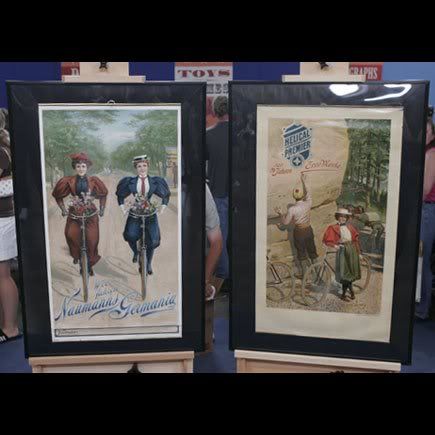 If you’re an Antiques Roadshow fanatic, you may recall the Bismarck, North Dakota appraisal of these two window cards for a 19th century bicycle company. The appraiser’s description included these remarks:
If you’re an Antiques Roadshow fanatic, you may recall the Bismarck, North Dakota appraisal of these two window cards for a 19th century bicycle company. The appraiser’s description included these remarks:
Now, in the 1880s and 1890s, bicycles were the hottest seller basically in any market. And specifically, bicycles were marketed to women, and you’ll see in both of these posters, the main subjects are women. In this poster nearest to me, you actually see two very affluent, well-dressed, stylish women out for perhaps a Sunday afternoon ride in the park. And you can imagine this is who the bicycle companies were appealing to. They really wanted women as their customers. These are very irresistible, very charming images. In the poster closer to you, not only do we see an emancipated woman who has gone for a ride with a man in the countryside, which would have been a fairly risque idea in the 1880s, but if you look at her pose, she is a very self-confident, a very modern woman. In the 1880s, that was really very progressive.
“Risque” and “very progressive” in the Gentile world of the 1880s, perhaps, but oh, my! wicked, apparently, in the Mormon world of the 1890s. Exhibit: This editorial, probably written by George Q. Cannon, in the 1 January 1896 issue of The Juvenile Instructor:
Bicycle Riding.
In conversation the other day with some of the leading officers of the Church concerning the sin of fornication – there being some cases of this kind submitted to the First Presidency – the question was asked, “What reason is there for these cases occurring at this time? It is [not] unusual to hear of three or four cases occurring in one city.”
The reply was that there were two causes: one, the intimacy which had grown up among young people of both sexes in bicycle riding; and the other, the taking part in excursion and other parties at untimely hours of the night.
We are not disposed to reject improvements or inventions which contribute to human progress and development. In fact, we are fond of progress, in the right direction, and would not say one word that could be construed into viewing it with disfavor. But we have entertained fears concerning the effects which are likely to follow the adoption of the bicycle as a means of locomotion for girls; and that which we have heard from the settlement to which we refer confirms fears that we have entertained concerning this practice. Any fashion that begets too great familiarity between the sexes, especially when they are young and inexperienced, is one that should be guarded against. We have noticed that bicycle riding brings about a certain comradeship between young people that might, under some circumstances, lead to unfortunate results. Certainly the practice creates acquaintanceship and familiarity that, if it were not for the riding, would not be created; and sometimes this acquaintanceship is not desirable. Girls may be thrown into society by riding bicycles that they would not meet with under other circumstances, and would perhaps shun if it were in the ordinary intercourse of society.
On this account we have felt that parents and guardians should exercise the greatest of care in allowing their daughters or those in their charge to go out riding on bicycles unless properly attended. it has been a question in many minds whether bicycle riding may not lead to immodesty and be injurious in other directions.
There are many things that may be said favorable to the use of the bicycle. It furnishes exercise, it is a delightful method of getting over the ground swiftly, and is exhilarating. Exercise in the open air is good for all. The question remains, however, whether this kind of exercise for young ladies is conducive to health, and especially to good morals.
We mention these cases of wrongdoing to call the attention of parents and others to the fact that they are attributed to the associations which have arisen through bicycle riding.
As to late hours and going to parties at untimely hours, there can be no question in any thinking person’s mind as to the effects which follow such practices; they are evil, it may be truthfully said, in every instance. No parents who have any regard for their children will permit them to be out late at night in promiscuous assemblages. Indulgence of that kind towards children will inevitably lead to bad consequences and result in sorrow to the parents as well as to the offspring. Too much cannot be said against such practices, and all should be warned against them; for if permitted, and they are followed up, they are almost sure to bring shame and disgrace.
Needless to say (so I’ll say it anyway), fornication is bad, too great familiarity is bad, undesirable acquaintanceship is bad. But why, oh, why does the heavy hand fall always on the girls? Were not fornication, too great familiarity, and undesirable acquaintanceship also bad for the boys? And why curtail bicycle riding, with all its admittedly favorable traits, rather than teach the girls (and boys) the importance of chastity and of proper social behavior even when bicycles are involved?
And then there’s the “question in many minds whether bicycle riding may not lead to immodesty and be injurious in other directions” – injurious in the direction that riding astride a horse or wearing pant-type underclothing had long been considered injurious, of course.
It just isn’t fair that so often, rather than dealing with the real problem, the proposed solution is the easy one of locking up the girls.
Okay, end of rant. For the time being. And yes, this touched a nerve in my own memory.
Continue reading at the original source →



